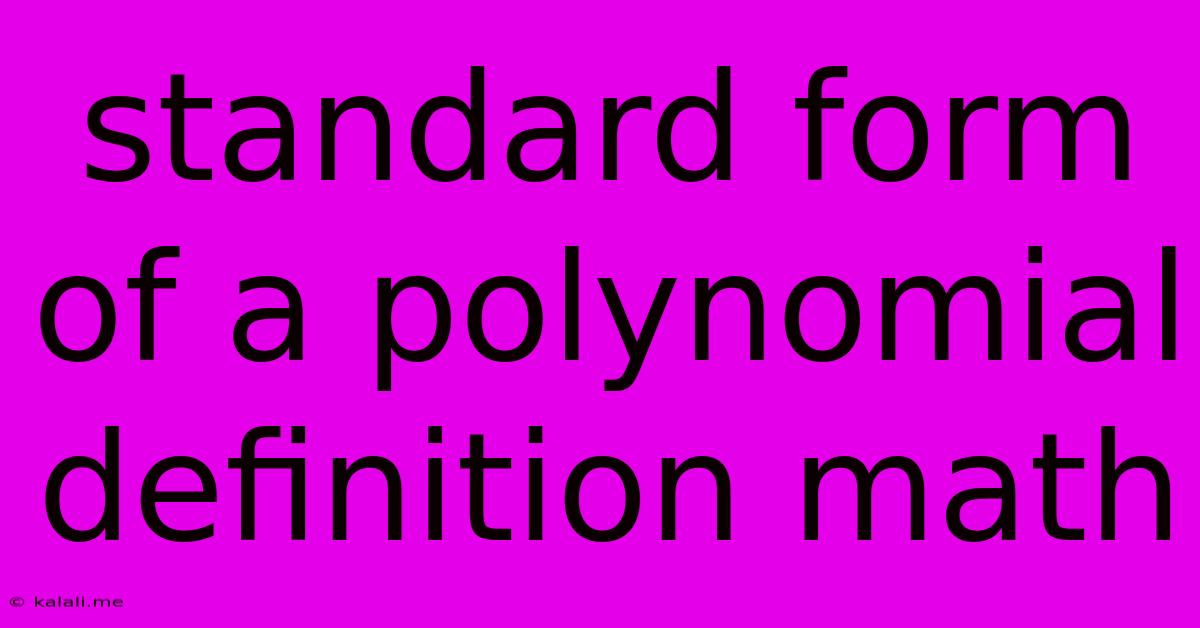Standard Form Of A Polynomial Definition Math
Kalali
May 09, 2025 · 3 min read

Table of Contents
Understanding the Standard Form of a Polynomial: A Comprehensive Guide
This article provides a comprehensive explanation of the standard form of a polynomial, a crucial concept in algebra. We will explore its definition, illustrate it with examples, and discuss its importance in various mathematical operations. Understanding the standard form simplifies polynomial manipulation and lays the foundation for more advanced algebraic concepts.
What is a Polynomial?
Before delving into the standard form, let's define a polynomial. A polynomial is an expression consisting of variables (often represented by x), coefficients, and exponents, combined using addition, subtraction, and multiplication. Crucially, the exponents must be non-negative integers. Examples include:
- 3x² + 2x - 5
- 7x⁴ - x² + 9
- 5x
- 12
Defining the Standard Form of a Polynomial
The standard form of a polynomial arranges its terms in descending order of their exponents. This means the term with the highest exponent comes first, followed by the term with the next highest exponent, and so on, until the constant term (the term without a variable) is last. Each term consists of a coefficient (a number multiplying the variable) and a variable raised to a power.
Key Characteristics of Standard Form:
- Descending Order of Exponents: The terms are arranged from the highest exponent to the lowest.
- Combined Like Terms: All similar terms (terms with the same variable and exponent) are combined into a single term.
- Simplified Expression: The polynomial is expressed in its most concise form.
Examples of Polynomials in Standard Form:
Let's illustrate with some examples:
-
Original Polynomial: 5x³ + 2x - 7x² + 9
-
Standard Form: 5x³ - 7x² + 2x + 9 (terms arranged in descending order of exponents)
-
Original Polynomial: 4x⁵ - 2x² + 6x⁵ + x - 8 + 3x²
-
Standard Form: 10x⁵ + x² + x - 8 (like terms combined and arranged in descending order)
-
Original Polynomial: -2x + 11 + 3x²
-
Standard Form: 3x² - 2x + 11
Why is Standard Form Important?
The standard form of a polynomial offers several significant advantages:
- Easy Comparison: It simplifies the comparison of polynomials, making it easier to identify similarities and differences.
- Simplified Operations: Performing operations like addition, subtraction, and multiplication becomes more efficient when polynomials are in standard form.
- Finding the Degree: The degree of a polynomial (the highest exponent) is immediately apparent in the standard form.
- Root Finding: Certain methods for finding the roots (solutions) of a polynomial equation are easier to apply when the polynomial is in standard form.
- Graphing: The standard form provides valuable information for graphing polynomials, allowing for easier identification of key features like intercepts and behavior at extreme values.
Identifying Polynomials and Non-Polynomials:
Remember, not all expressions are polynomials. Here’s what to look for:
- Non-negative Integer Exponents: Exponents must be whole numbers (0, 1, 2, 3...). Fractional or negative exponents indicate a non-polynomial expression.
- Allowed Operations: Only addition, subtraction, and multiplication are permitted. Division by a variable is not allowed.
Conclusion:
Understanding the standard form of a polynomial is foundational to success in algebra and related mathematical fields. By mastering this concept, you'll streamline polynomial operations and gain a deeper understanding of polynomial behavior. Practice writing polynomials in standard form to solidify your understanding and develop fluency in algebraic manipulation.
Latest Posts
Latest Posts
-
82 Inches To Feet And Inches
May 09, 2025
-
5 3 Cm Is How Many Inches
May 09, 2025
-
What State Of Matter Is The Outer Core
May 09, 2025
-
25 Is What Percentage Of 100
May 09, 2025
-
What Is 225 Degrees Celsius In Fahrenheit
May 09, 2025
Related Post
Thank you for visiting our website which covers about Standard Form Of A Polynomial Definition Math . We hope the information provided has been useful to you. Feel free to contact us if you have any questions or need further assistance. See you next time and don't miss to bookmark.